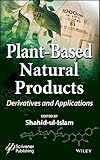Plant-based natural products : derivatives and applications / edited by Shahid-ul-Islam.
Material type: TextPublisher: Hoboken, NJ, USA : Beverly, MA, USA : John Wiley & Sons, Inc. ; Scrivener Publishing LLC, 2017Copyright date: ©2017Description: 1 online resource (xiii, 224 pages)Content type:
TextPublisher: Hoboken, NJ, USA : Beverly, MA, USA : John Wiley & Sons, Inc. ; Scrivener Publishing LLC, 2017Copyright date: ©2017Description: 1 online resource (xiii, 224 pages)Content type: - text
- computer
- online resource
- 9781119423874
- 1119423872
- 9781119423898
- 1119423899
- 9781119423881
- 1119423880
- Plant biotechnology
- Plant products
- Natural products
- Botanical chemistry
- SCIENCE -- Chemistry -- Organic
- TECHNOLOGY & ENGINEERING -- Agriculture -- Agronomy -- Crop Science
- TECHNOLOGY & ENGINEERING -- Agriculture -- Agronomy -- General
- Botanical chemistry
- Natural products
- Plant biotechnology
- Plant products
- 630 23
- TP248.27.P55 P524 2017
- SCI013040
Includes bibliographical references and index.
"Intense research has been started all around the world in the past few decades to exploit different agents from natural products as eco-friendly alternative to synthetic and toxic chemicals. Natural products and their derivatives have received increasing attention for their use in many everyday applications ranging from food, medicine, textiles, and healthcare. This new book presents significant research advances about the use of natural products, mainly plant colorants, bioactive compounds and other plant extracts in the textile coloration, food, bioremediation and environmental applications. There are total eight chapters contributed by leading researchers covering the topics such as potential resurgence of natural dyes in applied fields, natural colorants from indigoid plants, phytochemistry of dye yielding plants, irradiation as novel pretreatment methods, dyeing studies with henna plant, phytoremediation of arsenic, and synthesis of curcumin complexes for medicinal and other industrial uses"-- Provided by publisher.
Online resource; title from digital title page (viewed on August 11, 2017).
Cover; Title Page; Copyright Page; Contents; Preface; 1 Potential Resurgence of Natural Dyes in Applied Fields; 1.1 Introduction; 1.1.1 Types of Natural Dyes; 1.2 History; 1.3 Advantages of Natural Dyes; 1.4 Classification; 1.4.1 Structure Base; 1.5 Methods of Extraction and Dyeing; 1.5.1 Conventional Method; 1.5.2 Modern Method; 1.6 Potential Application of Natural Dyes; 1.6.1 Food; 1.6.2 Pharmaceutical/Medicinal; 1.6.3 Cosmetics; 1.6.4 Textile; 1.7 Conclusion; Acknowledgment; References; 2 Natural Dyes from Indigoid-Rich Plants: An Overview; 2.1 Introduction to Natural Dyes.
2.2 Indigoid Dyes: An Overview2.3 Indigo-Rich Plant Species: Practices and Discussion; 2.3.1 Indigofera tinctoria; 2.3.2 Polygonum tinctorium; 2.3.3 Isatis Sp.; 2.3.4 Tyrian Purple; 2.3.5 Baphicacanthus cusia; 2.3.6 Strobilanthes cusia; 2.4 Safety Aspects and Sustainability; 2.5 Conclusion and Future Outlook; References; 3 Phytochemical and Pharmacological Aspects of Butea monosperma L.; 3.1 Introduction; 3.2 Phytochemical Aspects; 3.2.1 Flavones, Flavonols, and Isoflavones; 3.2.2 Chalcones; 3.2.3 Pterocarpanes; 3.3 Sterols; 3.4 Imides; 3.5 Terpenoids; 3.6 Miscellaneous Compounds.
3.7 Biological Activities3.7.1 Antimicrobial Activity; 3.7.2 Anti-inflammatory; 3.7.3 Anticancer Activity; 3.7.4 Hepatoprotective Activity; 3.7.5 Anticonvulsant Activity; 3.7.6 Anti-diabetic Activities; 3.7.7 Other Biological Properties; 3.8 Conclusion; References; 4 Radiation Pretreatment: A Potential Novel Technology to Improve Fastness Properties of Plant-Derived Natural Dyes; 4.1 Introduction; 4.1.1 Natural Dyes; 4.1.2 Advantages and Health Aspects of Natural Dyes; 4.1.3 Economic Aspects of Natural Dyes; 4.2 Chemistry of Fabrics; 4.2.1 Chemistry of Cotton; 4.2.2 Chemistry of Wool.
4.2.3 Chemistry of Silk4.2.4 Chemistry of Polyester; 4.2.5 Chemistry of Polyamide; 4.3 Mordants and their Classification; 4.3.1 Classification of the Mordants; 4.3.1.1 Chemical Mordants; 4.3.1.2 Biomordants; 4.4 Radiation and Its Role in Dyeing; 4.4.1 Role of Ultraviolet Radiation; 4.4.2 Role of Microwave Radiation; 4.4.3 Role of Ultrasonic Radiation; 4.4.4 Role of Plasma Radiation; 4.4.5 Role of Gamma Radiation; 4.5 Applications of Mordants; 4.5.1 Application on Irradiated Cotton; 4.5.2 Application on Irradiated Wool; 4.5.3 Application on Polyamide (Nylon).
4.5.4 Application on Irradiated Polyester4.6 Conclusion; Acknowledgments; References; 5 Natural Colorant from Lawsonia inermis Leaves: Reflectance Spectroscopy-Induced Optimal Conditions of Extraction and Dyeing; 5.1 Introduction; 5.2 Materials and Methods; 5.2.1 Wool and Dye; 5.2.2 Pretreatment of Wool and Optimization of Dye Concentration; 5.2.3 Optimization for Extraction of L. inermis Extract; 5.2.4 Optimization for Dyeing with Optimal L. inermis Extract; 5.2.5 Color Measurement; 5.2.6 Fastness Tests; 5.2.6.1 Light Fastness; 5.2.6.2 Wash Fastness; 5.2.6.3 Rub Fastness.
There are no comments on this title.
